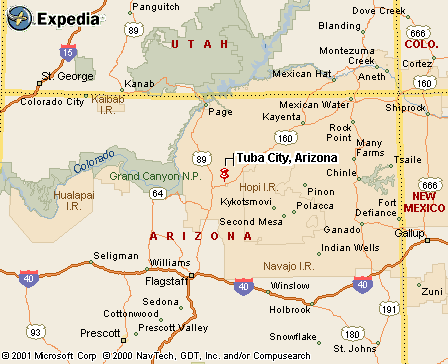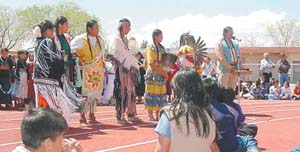|
|
Canku Ota |
|
|
(Many Paths) |
||
|
An Online Newsletter Celebrating Native America |
||
|
May 4 , 2002 - Issue 60 |
||
|
|
||
|
"Celebrating Our Indian-ness" |
||
|
by Suetopka
Thayer Navajo Hopi
Observer
|
||
|
credits:
Photo by Byron Poocha, George Multine III and Rosanda
ST
TC Media Team |
|
Recognizing, understanding, celebrating and renewing ties to culture and tradition was what this entire past week was all about. Administrators felt it was so important for their student population a memo was issued to endorse the week-long cultural activities for all of Tuba City District’s seven schools. What made this week even more special is that other cultures were featured alongside American Indian activities. Maori, Hawaiian, Hispanic, African American, and Anglo cultures all had something to contribute. Activities varied from traditional art forms like moccasin making, to plant identification and use, construction of traditional play forms made from mud to singing songs in native languages. Discussions about constellations were given to primary and middle school students. Wearing traditional clothing was heavily encouraged as well as conversing in one’s own first Native language. Students were extremely receptive to the
special presentations this week as it took them out of their ordinary
activities to celebrate their "Indian-ness." Norman Butler, a traditional Navajo Moccasin Maker who lives in Tuba City was one of the featured presenters at the TC Primary School. He learned his art form from his father. He shared with students the process of making traditional moccasins and talked to them about the meaning of each section of the moccasin itself. He showed how one must scrape all the hair off the cowhide before you can start on the bottom sole of the shoe. Then the cowhide must be steamed to form it to the foot. The top portion of the moccasin is made of dyed deerhide that has been tanned with animal brains. Butler also explained as he worked that
the moccasin has its own spiritual meaning. The toe section of the
moccasin represents the early morning dawn. The red deerhide leather
portion represents the sunset. The white deerhide wrap that goes
around the leg represents the Mother Earth and her protectiveness
as you walk. As Butler sewed, he told the students that even the way you stitch your leather will make a big difference in how the shoe ends up. Large stitches will make a higher lip on the shoe, while smaller stitches will make the cowhide sole lower and softer to walk on. The final day of activity included eating traditional foods and inviting their parents to their individual schools to assist, enjoy and support their week-long projects. |

|
www.expedia.com |
|
|
||
|
|
||
| Canku Ota is a free Newsletter celebrating Native America, its traditions and accomplishments . We do not provide subscriber or visitor names to anyone. Some articles presented in Canku Ota may contain copyright material. We have received appropriate permissions for republishing any articles. Material appearing here is distributed without profit or monetary gain to those who have expressed an interest. This is in accordance with Title 17 U.S.C. Section 107. | ||
|
Canku Ota is a copyright © 2000, 2001, 2002, 2003 of Vicki Lockard and Paul Barry. |
||
 |
 |
|
|
The "Canku Ota - A Newsletter Celebrating Native America" web site and its design is the |
||
|
Copyright © 1999, 2000, 2001, 2002, 2003 of Paul C. Barry. |
||
|
All Rights Reserved. |
||
 "I
feel lucky, honored too, but really, really lucky." This was
the response from a Tuba City High School student who is Hopi when
he was asked how he felt about being Indian.
"I
feel lucky, honored too, but really, really lucky." This was
the response from a Tuba City High School student who is Hopi when
he was asked how he felt about being Indian.